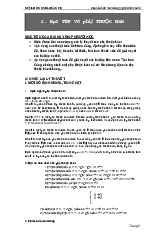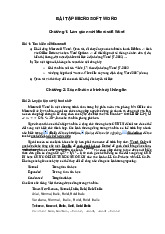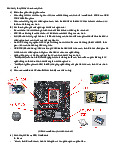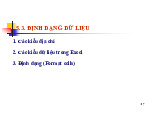





Preview text:
Keeping your computer physically clean
Dust isn't just unattractive—it can potentially damage or
even destroy parts of your computer. Cleaning your computer regularly will help you keep it working
properlyand avoid expensive repairs. Cleaning the keyboard
Dust, food, liquid, and other particles can get stuck
underneath the keys on your keyboard, which can prevent it
from working properly. The basic cleaning tips below can help keep your keyboard clean.
1. Unplug the keyboard from the USB or PS/2 port. If the
keyboard is plugged into the PS/2 port, you will need to shut
down the computer before unplugging it.
2. Turn the keyboard upside down and gently shake it to remove dirt and dust. 3. Use a can of to clean betwee compressed air n the keys. 4. Moisten a cotton or cloth
paper towel with rubbing
alcohol and use it to clean the tops of the keys. Do not pour
alcohol or any other liquid directly onto the keys.
5. Reconnect the keyboard to the computer once it is dry. If
you are connecting it to a PS/2 port, you will need to connect it tur before ning on the computer. Dealing with liquids
If you spill liquid on the keyboard, quickly shut down the
computer and disconnect the keyboard. Then turn the
keyboard upside down and allow the liquid to drain.
If the liquid is sticky, you will need to hold the keyboard on
its side under running water to rinse away the sticky liquid.
Then turn the keyboard upside down to drain for two days
before reconnecting it. Please note that keyboard may not be
fixable at this point, but the method above is probably the best option.
To prevent this situation altogether, we recommend
keeping drinks away from the computer area. Cleaning the mouse
There are two main mouse types: optical and mechanical.
Each is cleaned in basically the same way, although the
mechanical mouse requires a bit more work.
Optical mice require no internal cleaning because they
do not contain any rotating parts; however, they can
get sticky over time as dust collects near the light emitter.
This can cause erratic cursor movement or prevent the mouse from working properly. Mechanical mice are especially susceptible
to dust and particles that can accumulate inside the mouse,
which can make it difficult to track—or move—properly. If the
mouse pointer does not move smoothly, the mouse may need to be cleaned.
The basic cleaning tips below will help keep your mouse clean:
1. Unplug the mouse from the USB or PS/2 port. If the mouse
is plugged into the PS/2 port, you will need to shut down the computer before unplugging it. 2. Moisten a cotton
cloth with rubbing alcohol, and use it to
clean the top and bottom of the mouse.
3. If you have a mechanical mouse, remove the tracking
ball by turning the ball-cover ring counter-clockwise. Then
clean the tracking ball and the inside of the mouse with
a cotton cloth moistened with rubbing alcohol.
4. Allow all of the parts to dry before reassembling and
reconnecting the mouse. If you are connecting it to a PS/2
port, you will need to connect it before turning on the computer.
If you just want to give the mouse a quick cleaning, place it
on a clean sheet of paper and move the mouse back
and forth. Some of the dust and particles should rub off onto the paper. Cleaning the monitor
Dirt, fingerprints, and dust can make your computer screen
difficult to read; however, it's easy to clean your
screen when needed. There are monitor-cleaning kits you
can buy, but they may damage your monitor if they're
designed for a different type of monitor. For example, a
monitor cleaner that is designed for glass screens may not
work with some non-glass LCD screens. The safest method
is simply to use a soft clean cloth moistened with water.
Do not use glass cleaner to clean a monitor. Many screens
have anti-glare coatings that can be damaged by glass cleaner.
1. Turn of the computer.
2. Unplug the monitor from the power. If you are using a laptop, unplug the laptop. 3. Use a soft clean moistened cloth with water to wipe the screen clean.
Do not spray any liquids directly onto the screen. The liquid could
leak into the monitor and damage the internal components.
Tips for cleaning other computer surfaces
From time to time, you should clean your computer case
and the sides and back of the monitor to avoid a buildup of
dust and dirt. Here are a few tips you can use when cleaning these surfaces.
Dust is your computer's main enemy. Use an anti-
static cloth to lightly dust your computer casing. Do not use
furniture cleaners or strong solvents.
Use a can of compressed air to blow out debris from the air intake slots.
Ammonia diluted with water—or glass
cleaner comprised mostly of ammonia and water—is a safe
cleaning solution for computer surfaces. The milder the solution, the better.
Clean the monitor housing and case (but not the
monitor screen) by spraying a safe cleaning solution onto a
paper towel or anti-static cloth and wiping in a downward motion. Keep it cool
Don't restrict airflow around your computer. A computer
can generate a lot of heat, so the casing has fans that keep it
from overheating. Avoid stacking papers, books, and other items around your computer. Many computer desks have an enclosed
compartment for the computer case. If you have this type of
desk, you may want to position the case so it is not against
the back side of the desk. If the compartment has a door, you
may want to leave it open to improve airflow.




